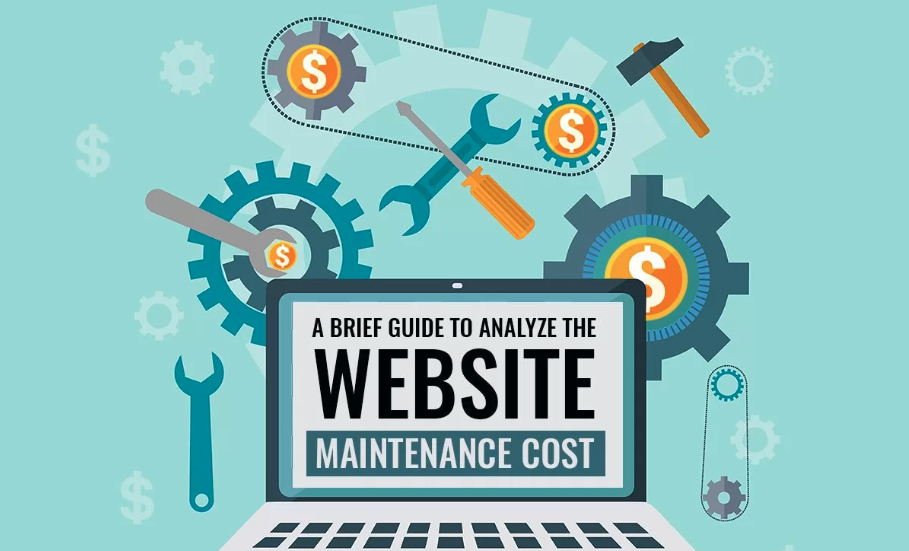The cost to maintain a website can be a difficult subject to discuss. It’s because the price range varies greatly depending on a number of factors, including the size of the website, the complexity of its features, and the web hosting provider selected.
When you use a website builder, you can expect minimal technical updates. However, you will still need to pay a monthly subscription fee to gain access to specific features or remove branding from your website.
But don’t worry too much about it. Today, we’ll try to break down every possible cost involved in maintaining your website. We hope that this article will help you understand how maintenance costs can vary depending on the size of your website and can be as low as $5 per month for a small business.
Factors Affecting Website Maintenance Costs
The factors that determine website maintenance costs include the complexity of the website, the type of services required, the size and functionality of the website, the number of mailboxes for email services, the level of tech support needed, the website design approach (self-designing or hiring a professional), the use of plugins and extensions, the inclusion of eCommerce features, and the extent of marketing and SEO efforts.
Essential Website Maintenance Cost
According to the Hostinger blog, a website’s monthly cost can range between $5 and $5,000. The following is a list of the average monthly maintenance costs for various types of websites in 2024:
| Website Type | Monthly Maintenance Cost |
| Personal Websites | $5 – $25/month |
| Professional Blogs | $25 – $75/month |
| Small to Medium Business Websites | $35 – $500/month |
| Multimedia Entertainment Websites | $300 – $2,500/month |
| Corporate Websites | $200 – $4,500/month |
| eCommerce Websites | $750 – $5,000/month |
Why, then, is there such a wide range of prices? Please keep in mind that these figures are averages and may vary depending on your website’s functionality and size.
For instance, compared to an eCommerce site, a personal website usually needs fewer features and storage. Another thing to keep in mind is that the highest end of the budget typically employs something that can be considered a luxury for small businesses, such as hiring a consultant or agency.
1. Domain
- Average costs: around $1-$100/year for registration and $10-$129/year for renewals
- Level of necessity: necessary
Every website needs a domain name. The cost of domain name registration varies depending on the extension and popularity. Popular extensions include generic top-level domains (gTLDs) such as .com, .net, and .org. There are also country-code top-level domains (ccTLDs) such as “.us” or “.jp”, and sponsored top-level domains (sTLDs) such as “.edu”.
When choosing a domain registrar, it’s advisable to use a reputable one to avoid scams and hidden fees.
Some hosting companies provide free domain registration with their hosting plans, so it is worth looking into these options to save money. There are even some all-in-one services that include domain registration, hosting, and website builders to assist you in designing your website. Furthermore, including domain privacy protection in your maintenance plan can add an extra layer of security to your personal information.
After you have purchased your domain, the next step is to set up web hosting.
2. Web Hosting
- Average costs: around $2–$80/month, depending on the provider, type, and subscription length.
- Level of necessity: necessary
Web hosting is a service that allows you to publish your website on the internet. Pricing for web hosting may vary depending on the provider, type of hosting (cloud, shared, VPS, or dedicated), and length of subscription.
When you want to buy hosting, there are some options that you can choose from. There is shared hosting, VPS hosting, cloud hosting, dedicated hosting, and even WordPress hosting. But what do all those options mean?
Shared hosting is a cost-effective option suitable for small to medium-sized websites.
VPS hosting provides dedicated resources within a shared server and offers more control for technically experienced users.
Cloud hosting ensures high uptime and is ideal for traffic-heavy websites.
Dedicated hosting allocates a dedicated server to a single website. With this hosting, you’ll have superior performance, but at a higher cost.
WordPress hosting is optimised for WordPress websites and provides additional tools and maintenance features.
Because most small businesses are just getting started with websites, you can simply choose shared hosting. When you first start a website, your traffic will be small. With less traffic, you benefit from lower-cost shared hosting with less RAM and storage.
3. Web Design
- Average costs: $0–$17/month for self-designing or $500–$1,000/year for hiring a professional
- Level of necessity: important
A good web design can improve search engine optimisation (SEO) and the user experience, which leads to more website visitors. There are two primary methods of website design: designing it yourself or hiring a professional.
Self-designing a website is a low-cost option for small to medium-sized businesses. Content management systems (CMS), such as WordPress, provide a range of free and premium themes for customising your website.
Another option is to use free website builders, which provide professionally designed templates and drag-and-drop functionality for easy customisation. You can choose from a variety of website builders. Make sure to check out our list of the best free website builders to help you pick the best one.
Hiring a professional web designer is more expensive, but it can result in a one-of-a-kind and engaging website that is tailored to your specific needs. Professional designers can also offer ongoing maintenance services, such as software updates and optimisation.
For a small business, we recommend choosing the option with the smallest budget: design your own website. Most website builders now provide simple drag-and-drop tools for designing your website. You can get some ideas from our tips on how to design a website that stands out and attracts customers.
4. Email Services
- Average costs: $1-$6/user/month
- Level of necessity: important
A business email is required for all types of small businesses. Email addresses in your domain name show your company’s professionalism and can help you gain customer trust while marketing your brand.
There are several options for getting an email service using your domain name as an address. The first option is Google Workspace. Google Workspace includes email addresses with your domain name as well as access to their entire productivity suite (Google Docs, Meet, Drive, and so on). The monthly cost starts at $3.60 USD (approximately $5.52 AUD). However, you should consider how large your team is. It’s because Google charges you that amount for each user who uses your account.
The best option for small businesses is to use your website hosting provider’s email services. Some all-in-one website hosting providers include email hosting in their packages. Check to see if your website hosting service also provides email hosting. Check out our list of the best website builders to find the right one for your small business.
5. eCommerce Features
- Average costs: $15/month for regular-sized online stores
- Level of necessity: optional
Not all small businesses need eCommerce features. However, if you are selling a large number of physical products, an eCommerce feature is important.
Most all-in-one website builders charge an extra fee for eCommerce features such as payment gateways, inventory management, and dedicated support. The total cost of eCommerce features varies according to your online store’s specific requirements.
eCommerce platforms such as WooCommerce, Shopify, and Magento provide a variety of plans with differing features and pricing. When budgeting for maintenance costs, take into account the size of your online store, the number of products and services you sell, and the specific eCommerce features you need.

6. Marketing and SEO
- Average costs: $0–$500/month
- Level of necessity: important
Marketing is the reason why a small business wants to create its own website, and SEO is the most important aspect of internet marketing. SEO may appear to be a technical term, but basic optimisation can be completed by anyone with a little knowledge and effort.
For example, using relevant keywords to write your website’s content can be considered an optimisation effort and can help your website rank higher in search engine results. Using a small-sized image is another way to boost your website’s loading speed and user experience. Writing content about your small business is also considered an SEO best practice.
So that’s why SEO and marketing maintenance costs start at zero because you can do it yourself, especially if you’re a small business just getting started. When your business begins to grow, you may require assistance from an experienced SEO professional or marketing agency. At that point, you can begin planning your marketing and SEO budget so that your business can grow even further.
7. Tech Support
- Average costs: $2-$300/month
- Level of necessity: important
Having access to technical support can be extremely helpful in resolving any issues that may arise with your website. Whether you’re a beginner or an experienced user, having a customer service team on hand can help you resolve issues before they affect your website’s performance and user experience.
Tech support can take many forms, including live chat, email ticketing systems, phone service, and knowledge databases. Many hosting providers include live chat and email support in their plans, with premium support available for larger websites or businesses that require immediate and personalised assistance.
As a small business, you don’t need to overthink tech support. A small-scale website usually doesn’t need 24/7 tech support as their traffic and technical requirements are typically low. You can use the tech support from hosting providers that usually comes in a package with your website hosting plan
How Often Is Website Maintenance Required?
There are no set rules for how frequently website maintenance procedures should be performed. However, it is recommended to have a monthly maintenance checklist to guarantee that everything is running smoothly and up-to-date. Routine maintenance helps to avoid errors, security breaches, and performance issues.
Some maintenance tasks, such as domain name and hosting renewals, are done annually. Others, such as marketing and SEO initiatives, may necessitate quarterly updates. Regularly updating your website’s software, including CMS and plugins, is critical for preventing security vulnerabilities and guaranteeing optimal performance.
If you have the resources, consider hiring professional website maintenance services. They can handle technical tasks such as backups, security measures, core updates, and troubleshooting, saving you time and effort.
Should I Maintain the Website Myself or Hire a developer?
When it comes to website maintenance, you have two main options: hiring a professional or doing it yourself. Let’s explore the pros and cons of each approach:
Hiring a Professional
- Average cost: $200–$4,500/month
Hiring a website maintenance service provider will save you time and effort. They have the expertise and tools required to handle the more complex technical aspects of website maintenance, such as software updates, security audits, and performance optimization. Website maintenance service providers frequently offer fixed packages that include ongoing support and maintenance.
However, hiring a professional costs more than self-maintenance. The exact amount you pay will be determined by the scope of services provided and your agreement with the service provider. Before hiring a professional, you should carefully consider your budget as well as your website’s specific needs.
Self-Maintenance
- Average cost: under $100/month
Doing website maintenance yourself is a more affordable option, especially for small business owners or individuals who prefer to be hands-on with their website. It allows you to have complete control over your site configurations and can help you develop new skills.
However, self-maintenance requires time and effort to learn and implement technical tasks correctly. It’s important to stay updated with the latest industry trends and best practices to make sure your website remains secure and up-to-date. If you decide to self-manage your website, consider using website builders. Most website builders are simple to use and do not require technical skills to maintain. This makes maintenance easier for beginners.
Conclusion
In 2024, the average monthly maintenance costs for different types of websites will range from $5 to $5,000. Costs can include domain name registration and renewal, web hosting, SSL certificates, email services, tech support, website design, eCommerce features, and marketing and SEO strategies.
Don’t have a website yet and want to create one for your business? You should check out Nexa Lab’s web application development services. We offer customised solutions to businesses of all sizes, including small businesses.
We offer the best web app development services that ensure scalability and performance, as well as comprehensive testing and quality assurance, security, and compliance. We also offer maintenance and support.




